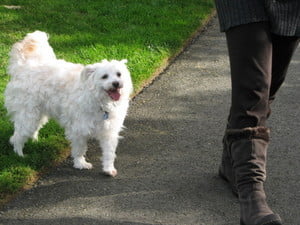Over years of training rescue dogs, I came to recognize different training tips for different rescue situations. Dogs from “broken homes” were very different to train than rescue dogs from puppy mills or shelters. Dogs that were neglected were different from ones who were abused. You can expect different behavioral issues from rescue dogs, and the following 10 dog training tips for rescue dogs are the ones I found most helpful in turning my troublesome mutts into lovable fury companions.
#1. POTTY-TRAINING
The greatest challenge you’ll face with dog training a rescue dog will revolve around potty training. Remember that your dog has gone through life without restrictions on where he can pee or poop. Now, he must learn new rules. There are several dog training tips that can help.
1. Limited Space. Begin by minimizing the area in which your rescue dog is allowed to roam. Let’s say you spend most of your time in your bedroom. Your rescue dog will begin to associate this area with you and the new rules of the home. He is more likely to defecate or urinate in other areas of the home, which he doesn’t yet recognize as part of his new life. By closing doors or installing pet gates, you can limit the area and make it easier for your dog to master the new rule. Then slowly increase the size of the “home area” until your rescue dog becomes fully potty trained.
2. Frequent Outside Visits. Take your rescue dog out regularly and lavish love and treats on him when he does his business outside. Conversely, do not yell or hit your rescue dog if he makes a mistake in the home. Instead, tell him “No” and take him out, repeating the congratulation words you used before, “Make pipi outside, good boy.”
3. Proper Cleanup. Dog training for rescue dogs is as much about teaching new habits as removing temptations. Once your furry friend does his business in the house, be sure to clean up the mess thoroughly. Rugs or carpets must be cleaned with odor eliminating cleaners, which you can find in the supermarket or pet stores. If any scent lingers, your dog will find the spot again and think that peeing or pooping here is allowed.
4. Patience and Consistency. When training a rescue dog you’ll find that almost at once your dog will prefer to remain indoors with you, where he feels safe. Going outside, even to the backyard, to do his business will be scary. Prepare to go out with your rescue dog and close the door to the house. Stay with him for as long as it takes, encouraging him by use of your dog training words (pipi outside, or potty outside).
5. Reduce Stress. If it’s cold outside, put a sweater on your rescue dog before you go outside for potty training. If it’s raining, try to find a spot in the garden that will be more sheltered. In short, try to minimize unpleasantness, so dog training your rescue dog will become all about potty training and not about other issues.
For in-depth dog potty training, please visit my: Dog-Training from “A” to “Zoo”
#2. DOG-TO-DOG AGGRESSION TRAINING
Dog training for rescue dogs always involves some degree of aggression training. Even my most fearful puppy mill rescue dog, Lily, would turn aggressive if someone came near her when she was given a dog toy. It’s important to identify the things that will bring out the aggression in your rescue dog, then to gently counter them.
1. Aggression Testing. To identify aggressive behavior in your rescue dog run a few tests on her. Touch her everywhere and see if she gets “touchy” about in part of her, say the tail. Give your dog a snack and see how she reacts if you try to take it away. Take your dog to the park and see how she reacts around other dogs.
2. Address Aggression. Dog training for rescue dogs is always about building trust. Your rescue dog will show aggression when he feels that no one else is there to protect him. You must teach him that, from here on, you’ll take care of him and make aggression unnecessary. Be firm with your dog and never let him get away with any aggression. This includes using a firm voice and firm body language. When your rescue dog is being possessive, take his possession away from him until he learns to accept your right to do so. When your dog is aggressive with others, keep him behind you and by your body language and voice become a barrier between him and other dogs. He will then learn to trust that you will protect him. And with trust aggression will become unnecessary.
#3. ANXIETY TRAINING
One of the saddest aspects of dog training rescue dogs is the question of separation anxiety. As your dog improves, he will come to love you-the person who saved him from loneliness, pain and fear. But when you leave home, your dog will be faced with being alone again. My puppy mill rescue, Ketty, would start whining loudly when I left home. She would get a panic attack and have trouble breathing. My husband who stayed home with her could do nothing to calm her. But with time, we learned a few dog training tips that helped.
1. Set the Mood. Once you leave, your home becomes quiet and empty. To counter this, leave soothing music on. Place your dog’s favorite toy on a familiar blanket. Give him a chew stick to munch on in your absence. And leave a shirt that smells of you near him. All these tips have helped give my Ketty the reassurance she needed when I left home.
2. Confuse the Moment. Ketty would always know that I was about to leave home when I put on my shoes and picked up my purse. I then relied on a simple dog training tip I picked up from a friend. I would put on my shoes, take my purse, and then sit down in the living room for another hour. I would get up from time to time, until Ketty stopped associating my actions with leaving home. When I actually left, this little rescue dog was too confused to notice.
3. Remove Temptations. My rescue dog, Lily, would chew the blinds and sofa when I was out. It was impossible to engage in dog training after the fact, because Lily couldn’t connect the chewed blind with the moment of my absence once I was back home. Instead, I raised the blinds and covered the sofa with a sheet. Lily was then left to chew on her chew stick, because that was the only thing available.
#4. FOOD TRAINING
Dog training tips for rescue dogs are very different when it comes to food training. Unlike dogs from bad homes, puppy mill dogs are used to fighting over their food. They will, therefore, attack any plate of food you place before them and gobble everything in a moment. Here are a few dog training tips that I find helpful.
1. Separate Spaces. To stop my rescue dogs competing over their food I separated them at feeding time. I sat on the floor in the center, and each of their plates was placed on another side of me. With me, the dog trainer, between them, each of my rescue dogs felt safe to eat without worrying about his food getting stolen.
2. Complete Separation. In extreme cases of food anxiety, complete separation might be needed. My puppy mill rescue, Lily, only got over her anxiety if she was allowed to eat alone, in the bathroom, with the door closed.
3. Apportioning. My rescue dog, Ketty, will still gobble up her food if you let her. I , therefore, apportion her meal, giving her 1/10 at a time. This slows down her eating process. It also adds time when I have to reach for the serving plate and give her the next portion. Ketty’s brain is given the opportunity to realize that she is less hungry, and so she starts to eat more slowly.
4. Repeat Feeding. By giving my rescue dogs breakfast, lunch and dinner, I prevent them from ever getting that sensation of starving, which reminds them of their unhappy past. Even when I am out of the house, I leave a chew sticks behind, and a small plate of dry food which no one really likes much but which gives them something to eat if they get desperate.
#5. TERRITORY MARKING TRAINING
This is an especially tricky dog training issue when it comes to rescue dogs. Not all of them will pee in the house to mark their territory, but rescue dogs from puppy mills or other conditions in which many dogs were mixed together are likely to require territory marking dog training.
1. Identify the Pattern. My rescue dog, Ketty, would urinate on her doggie bed. By observing her pattern of behavior I realized that she would pee only when I was out of the house or too busy in the house to pay attention to her. She would pee on the bed for two reasons: 1. She was afraid to go out by herself using the pet patio door, and I was too busy to take her out. 2. She didn’t want the other dogs to use her bed.
2. Remove Temptation. Once you understand the conditions under which your rescue dog is likely to mark his territory, remove the temptation. In Ketty’s case, I removed her doggie bed during the day and only gave it to her at night, when we were all going to sleep. If your dog is likely to mark his territory in one area of the house, keep him out of it. If he is more likely to urinate in the presence of dog toys or chew sticks, limit these and be around to keep the peace between him and other dogs.
#6. GROOMING TRAINING
Dog training tips for rescue dogs are just as important when it comes to grooming. My rescue dog, Sophie, looked like a dirty rag when I got her. Her fur had grown all over her eyes, nose and mouth. You can only imagine how difficult it was to groom her face when she wouldn’t sit still. Here are the dog training tips I learned for grooming my rescue dogs.
1. Soothing Atmosphere. Your rescue dog never experienced grooming. It’s up to you to make him love it. Begin with something pleasant. Place him on your bed with soft music in the background and simply caress him, nothing more.
2. Take Your Time. If you’re willing to take as long as needed, you won’t need to hurt your dog while trying to remove knots or get him to stand still. If you remain calm, your dog will remain calm. This passive dog training will translate to a set of expectations on the part of your dog. He will expect to be pampered and will learn to love grooming.
3. Be Gentle. Use scissors to gently cut away any knots. Swaddle your dog so his paws and body remain still, while you groom sensitive areas like eyes or the muzzle.
For in-depth dog grooming training, please visit my: Best Dog-Grooming Articles Collection.
#7. TRUST TRAINING
At the heart of all dog training tips for rescue dogs lies the issue of trust. Once your dog learns to trust you, several things will happen.
1. Elimination of Aggression. Once your rescue dog learns to trust that you will protect him, he will stop trying to do it for himself. His aggression towards other dogs will fade.
2. Instill Calm. When your rescue dog learns to trust that you will always feed him, his anxiety around food will fade. He will also remain calm if you take away his chew stick or toy.
3. Make Training Easy. With trust, your rescue dog will also learn to love you and wish to obey you. This lies at the heart of all dog training, the desire of a dog to please his master.
#8. DOG-TO-HUMAN AGGRESSION TRAINING
In cases of prior abuse, dog training tips for rescue dogs must take into account a fear of humans. My puppy mill rescue, Lily, was clearly abused in her past. She remains fearful of humans, which may translate into cowering or aggression depending on circumstances. Here are the dog training tips I learned from her.
1. Set a Standard. At the heart of your dog training set a standard of human behavior that your rescue dog can expect from now on. This will include no yelling or violence of any kind. Though your dog will still react as he used to in response to stress, he will very soon exhibit signs of shame at being unnecessarily aggressive. In fact, my rescue dog, Ketty, looks as if she wishes she could say, “Oh, I’m so sorry. I forgot. You’re my Mommy. You never hurt me.”
2. Avoid Feared Patterns. Even after two years with us, Lily remained fearful of certain actions. We learned to recognize what these actions were and avoid them. We wouldn’t raise our hand over her head. We would walk slowly beside her not to give the impression that she was about to be kicked. We would never walk toward her quickly, but rather call her to come to us. By recognizing the triggers of fear and aggression, we were able to avoid them and train our rescue dogs to forget their past.
#9. SMEAR TRAINING
All dogs seem to have a fascination with smelly things, but dog training tips on the subject are especially important with rescue dogs who take the art to a new height.
1. Recognize the Signs. Before my rescue dog, Goldie, smeared her head in poop, she would make a grunting sound and start walking around the area in a circle. My Rescue dog, Dorian, would paw at the area. His sister, Sophie, would look terribly excited. By learning to recognize the warning signs, I was able to proceed with dog training immediately. I would say, “No Smear”, and call my dogs to me.
2. Show Displeasure. When I didn’t react fast enough, my dogs would have their smear and eat it too. I would then cut the walk or play time short and go home to give them a bath. I would be quiet instead of fun to be with. And I would talk in a serious voice, saying that I wasn’t happy, that they were smelly now. They didn’t understand my words, but my manner and voice spoke volumes.
#10. BARK TRAINING
I’ve left bark training to the end, because it is likely the one dog training tip that will fail as often as it will work. Indeed, there are ways to reduce barking, but try to remember that dogs bark to communicate, and just as humans find it hard to shut up, so do dogs. Still, here are the dog training tips that work.
1. Identify the Bark. Not all barks are created equal. My rescue dog, Sophie, barks most often when she wants someone to play with her. Ketty, on the other hand, barks because she’s bored. Lily barks once in a blue moon when she feels terrified, and Dorian barks when someone else barks. By understand the reason for the bark you can eliminate the cause.
2. Fearful Barks. If your dog is barking from fear, yelling at him will increase his anxiety. Instead, play on the motif of trust, remind your rescue dog that you will protect him come what may. Tell him “good boy” for warning you that something is wrong, but make it clear that from here on you’re taking over. “It’s ok now”. Time to stop baking.
3. Bored Barks. Dog training for bored barks is fairly easy. Distract your dog with a toy or chew stick. And tell him not to bark. Be firm and your dog’s wish to please you will override his boredom.
4. Social Barking. The social barker is easy to fix with dog training. Limit his exposure to barks, and he’ll have nothing to join in with. In addition, simply saying “No” will prove beneficial with a social barker, as this dog wants to join in with whatever’s cool at the moment.
I hope this collection of dog training tips for rescue dogs will help make your fury friend the model pet he or she can be. And for an in-depth look at canine health, here are my 30 Important Dog-Health Questions and Answers .





